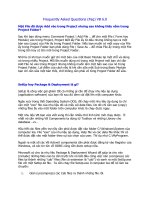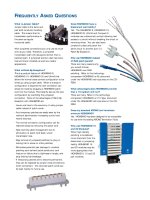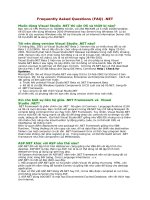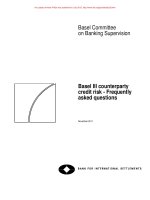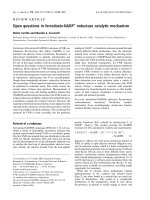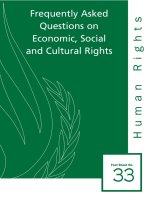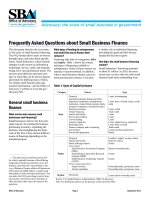commonly asked questions in thermodynamics
Bạn đang xem bản rút gọn của tài liệu. Xem và tải ngay bản đầy đủ của tài liệu tại đây (5.39 MB, 352 trang )
Commonly Asked Questions in
THERMODYNAMICS
CRC Press is an imprint of the
Taylor & Francis Group, an informa business
Boca Raton London New York
Marc J. Assael
Aristotle University, Thessaloniki, Greece
Anthony R. H. Goodwin
Schlumberger Technology Corporation, Sugar Land,Texas, USA
Michael Stamatoudis
Aristotle University, Thessaloniki, Greece
William A. Wakeham
University of Southampton, United Kingdom
Stefan Will
Universitat Bremen, Bremen, Germany
Commonly Asked Questions in
THERMODYNAMICS
CRC Press
Taylor & Francis Group
6000 Broken Sound Parkway NW, Suite 300
Boca Raton, FL 33487-2742
© 2011 by Taylor and Francis Group, LLC
CRC Press is an imprint of Taylor & Francis Group, an Informa business
No claim to original U.S. Government works
Printed in the United States of America on acid-free paper
10 9 8 7 6 5 4 3 2 1
International Standard Book Number-13: 978-1-4200-8696-6 (Ebook-PDF)
This book contains information obtained from authentic and highly regarded sources. Reasonable efforts have been
made to publish reliable data and information, but the author and publisher cannot assume responsibility for the
validity of all materials or the consequences of their use. The authors and publishers have attempted to trace the
copyright holders of all material reproduced in this publication and apologize to copyright holders if permission to
publish in this form has not been obtained. If any copyright material has not been acknowledged please write and let
us know so we may rectify in any future reprint.
Except as permitted under U.S. Copyright Law, no part of this book may be reprinted, reproduced, transmitted,
or utilized in any form by any electronic, mechanical, or other means, now known or hereafter invented, includ-
ing photocopying, microfilming, and recording, or in any information storage or retrieval system, without written
permission from the publishers.
For permission to photocopy or use material electronically from this work, please access www.copyright.com
( or contact the Copyright Clearance Center, Inc. (CCC), 222 Rosewood Drive, Danvers,
MA 01923, 978-750-8400. CCC is a not-for-profit organization that provides licenses and registration for a variety
of users. For organizations that have been granted a photocopy license by the CCC, a separate system of payment
has been arranged.
Trademark Notice: Product or corporate names may be trademarks or registered trademarks, and are used only for
identification and explanation without intent to infringe.
Visit the Taylor & Francis Web site at
and the CRC Press Web site at
e authors are indebted individually and collectively to a
large body of students whom they have taught in many
universities in di erent countries of the world. It is the
continually renewed inquisitiveness of students that provides
both the greatest challenge and reward from teaching in a
university. It is not possible for us to single out individual
students who have asked stimulating and interesting questions
over a career of teaching in universities.
vii
Contents
Preface xv
Authors xvii
1 Defi nitions and the 1
st
Law of Thermodynamics 1
1.1 Introduction 1
1.2 What Is ermodynamics? 2
1.3 What Vocabulary Is Needed to Understand ermodynamics? 3
1.3.1 What Is a System? 3
1.3.2 What Is a State? 3
1.3.3 What Are the Types of Property: Extensive and Intensive? 4
1.3.4 What Is a Phase? 4
1.3.5 What Is a ermodynamic Process? 5
1.3.6 What Is Adiabatic? 5
1.3.7 What Is Work? 5
1.3.8 What Is a Reversible Process or Reversible Change? 6
1.3.9 What Are ermal Equilibrium and the Zeroth Law of
ermodynamics? 7
1.3.10 What Is Chemical Composition? 8
1.3.11 What Is the Amount of Substance? 8
1.3.12 What Are Molar and Mass or Speci c Quantities? 9
1.3.13 What Is Mole Fraction? 10
1.3.14 What Are Partial Molar Quantities? 10
1.3.15 What Are Molar Quantities of Mixing? 12
1.3.16 What Are Mixtures, Solutions, and Molality? 12
1.3.17 What Are Dilution and In nite Dilution? 13
1.3.18 What Is the Extent of Chemical Reaction? 14
1.4 What Are Intermolecular Forces and How Do
We Know ey Exist? 14
1.4.1 What Is the Intermolecular Potential Energy? 14
1.4.2 What Is the Origin of Intermolecular Forces? 17
1.4.3 What Are Model Pair Potentials and Why Do We Need em? 18
1.4.3.1 What Is a Hard-Sphere Potential? 18
1.4.3.2 What Is a Square Well Potential? 19
Contents
viii
1.4.3.3 What Is a Lennard-Jones (12–6) Potential? 20
1.4.3.4 What Is the Potential for Nonspherical Systems? 21
1.4.4 Is ere Direct Evidence of the Existence of Intermolecular
Forces? 22
1.5 What Is ermodynamic Energy? 23
1.6 What Is the 1
st
Law of ermodynamics? 23
1.7 Questions at Serve as Examples of Work and the 1
st
Law of
ermodynamics? 24
1.7.1 How Does a Dewar Flask Work? 24
1.7.2 In a ermally Isolated Room Why Does the Temperature
Go Up When a Refrigerator Powered by a Compressor Is
Placed Within? 26
1.7.3 What Is the 1
st
Law for a Steady-State Flow System? 27
1.7.4 What Is the Best Mode of Operation for a Gas Compressor? 30
1.7.5 What Is the Work Required for an Isothermal Compression? 31
1.7.6 What Is the Work Required for an Adiabatic Compression? 32
1.8 How Are ermophysical Properties Measured? 35
1.8.1 How Is Temperature Measured? 36
1.8.2 How Is Pressure Measured? 37
1.8.3 How Are Energy and Enthalpy Di erences Measured? 37
1.8.4 How Is the Energy or Enthalpy Change of a Chemical
Reaction Measured? 39
1.8.5 How Is Heat Capacity Measured? 39
1.8.6 How Do I Measure the Energy in a Food Substance? 41
1.8.7 What Is an Adiabatic Flow Calorimeter? 43
1.9 What Is the Di erence between Uncertainty and Accuracy? 45
1.10 What Are Standard Quantities and How Are ey Used? 46
1.11 What Mathematical Relationships Are Useful in ermodynamics? 51
1.11.1 What Is Partial Di erentiation? 51
1.11.2 What Is Euler’s eorem? 54
1.11.3 What Is Taylor’s eorem? 54
1.11.4 What Is the Euler–MacLaurin eorem? 55
1.12 References 55
2 What Is Statistical Mechanics? 59
2.1 Introduction 59
2.2 What Is Boltzmann’s Distribution? 61
2.3 How Do I Evaluate the Partition Function q? 62
2.4 What Can Be Calculated Using the Molecular Partition Function? 66
2.4.1 What Is the Heat Capacity of an Ideal Diatomic Gas? 66
2.4.2 What Is the Heat Capacity of a Crystal? 67
Contents
ix
2.4.3 What Is the Change of Gibbs Function Associated with the
Formation of a Mixture of Gases? 68
2.4.4 What Is the Equilibrium Constant for a Chemical Reaction
in a Gas? 70
2.4.5 What Is the Entropy of a Perfect Gas? 72
2.5 Can Statistical Mechanics Be Used to Calculate the Properties of
Real Fluids? 73
2.5.1 What Is the Canonical Partition Function? 74
2.5.2 Why Is the Calculation so Di cult for Real Systems? 77
2.6 What Are Real, Ideal, and Perfect Gases and Fluids? 78
2.7 What Is the Virial Equation and Why Is It Useful? 81
2.7.1 What Happens to the Virial Series for Mixtures? 86
2.8 What Is the Principle of Corresponding States? 87
2.8.1 How Can the Principle of Corresponding States Be Used
to Estimate Properties? 91
2.9 What Is Entropy S? 94
2.9.1 How Can I Interpret Entropy Changes? 96
2.10 References 96
3 2
nd
Law of Thermodynamics 101
3.1 Introduction 101
3.2 What Are the Two 2
nd
Laws? 101
3.2.1 What Is Law 2a? 102
3.2.2 What Is Law 2b? 102
3.3 What Do I Do if ere Are Other Independent Variables? 104
3.3.1 Is Zero a Characteristic ermodynamic Function? 106
3.4 What Happens When ere Is a Chemical Reaction? 107
3.5 What Am I Able To Do Knowing Law 2a? 109
3.5.1 How Do I Calculate Entropy, Gibbs Function, and
Enthalpy Changes? 109
3.5.2 How Do I Calculate Expansivity and Compressibility? 113
3.5.3 What Can I Gain from Measuring the Speed of Sound in
Fluids? 115
3.5.4 What Can I Gain from Measuring the Speed of Sound in
Solids? 117
3.5.5 Can I Evaluate the Isobaric Heat Capacity from the
Isochoric Heat Capacity? 118
3.5.6 Why Use an Isentropic Expansion to Liquefy a Gas? 119
3.5.7 Does Expansion of a Gas at Constant Energy Change Its
Temperature? 119
3.5.8 What Is a Joule- omson Expansion? 121
Contents
x
3.6 What Am I Able to Do Knowing Law 2b? 122
3.6.1 How Are ermal Equilibrium and Stability Ensured? 122
3.6.2 How Are Mechanical Equilibrium and Stability Ensured? 123
3.6.3 How Are Di usive Equilibrium and Stability Ensured? 124
3.7 Is ere a 3
rd
Law? 126
3.8 How Is the 2
nd
Law Connected to the E ciency of a Heat Engine? 128
3.9 What Is Exergy Good For? 131
3.10 References 136
4 Phase Equilibria 139
4.1 Introduction 139
4.1.1 What Is the Phase Rule? 140
4.2 What Is Phase Equilibrium of a Pure Substance? 141
4.2.1 What Does Clapeyron’s Equation Have to Do with
Ice-Skating? 146
4.2.2 How Do I Calculate the Chemical Potential? 148
4.3 What Is the Condition of Equilibrium between Two Phases of a
Mixture of Substances? 150
4.3.1 What Is the Relationship between Several Chemical
Potentials in a Mixture? 151
4.3.2 What Can Be Done with the Di erences in Chemical
Potential? 151
4.3.3 How Do I Measure Chemical Potential Di erences (What
Is Osmotic Pressure)? 151
4.4 Do I Have to Use Chemical Potentials? What Is Fugacity? 154
4.4.1 Can Fugacity Be Used to Calculate (Liquid + Vapor) Phase
Equilibrium? 156
4.5 What Are Ideal Liquid Mixtures? 158
4.6 What Are Activity Coe cients? 159
4.6.1 How Do I Measure the Ratio of Absolute Activities at a
Phase Transition? 165
4.6.2 What Is ermodynamic Consistency? 167
4.6.3 How Do I Use Activity Coe cients Combined with Fugacity
to Model Phase Equilibrium? 168
4.6.4 How Do We Obtain Activity Coe cients? 169
4.6.5 Activity Coe cient Models 170
4.6.6 How Can I Estimate the Equilibrium Mole Fractions of a
Component in a Phase? 172
4.7 How Do I Calculate Vapor + Liquid Equilibrium? 173
4.7.1 Is ere a Di erence between a Gas and a Vapor? 173
4.7.2 Which Equations of State Should Be Used in Engineering
VLE Calculations? 179
Contents
xi
4.7.3 What Is a Bubble-Point or Dew-Point Calculation and
Why Is It Important? 183
4.7.4 What Is a Flash Calculation? 186
4.7.4.1 What Is an Isothermal Flash? 186
4.7.4.2 What Is an Isenthalpic Flash? 189
4.7.4.3 What Is an Isentropic Flash? 189
4.8 Would Practical Examples Help? 190
4.8.1 What Is the Minimum Work Required to Separate Air into
Its Constituents? 190
4.8.2 How Does a Cooling Tower Work? 194
4.9 What Is the Temperature Change of Dilution? 196
4.10 What about Liquid + Liquid and Solid + Liquid Equilibria? 202
4.10.1 What Are Conformal Mixtures? 202
4.10.2 What Are Simple Mixtures? 202
4.10.3 What Are Partially Miscible Liquid Mixtures? 203
4.10.4 What Are Critical Points in Liquid Mixtures? 204
4.10.5 What about the Equilibrium of Liquid Mixtures and Pure
Solids? 206
4.11 What Particular Features Do Phase Equilibria Have? 206
4.11.1 What Is a Simple Phase Diagram? 207
4.11.2 What Is Retrograde Condensation (or Evaporation)? 208
4.11.3 What Is the Barotropic
E ect? 208
4.11.4 What Is Azeotropy? 209
4.12 What Are Solutions? 210
4.12.1 What Is the Activity Coe cient at In nite Dilution? 210
4.12.2 What Is the Osmotic Coe cient of the Solvent? 211
4.13 References 212
5 Reactions, Electrolytes, and Nonequilibrium 217
5.1 Introduction 217
5.2 What Is Chemical Equilibrium? 217
5.2.1 What Are Enthalpies of Reaction? 218
5.3 What Are Equilibrium Constants? 222
5.3.1 What Is the Temperature Dependence of the Equilibrium
Constant? 223
5.3.2 What Is the Equilibrium Constant for a Reacting
Gas Mixture? 224
5.3.3 What Is the Equilibrium Constant for Reacting Liquid or
Solid Mixtures? 226
5.3.4 What Is the Equilibrium Constant for Reacting Solutes in
Solution? 227
Contents
xii
5.3.5 What Are the Enthalpy Changes in Mixtures with
Chemical Reactions? 229
5.3.6 What Is the di erence between Δ
r
G
m
and Δ
r
G
⦵
m
? 230
5.4 What Is Irreversible ermodynamics? 232
5.5 What Are Galvanic Cells? 234
5.5.1 What Is a Standard Electromotive Force? 238
5.6 What Is Special about Electrolyte Solutions? 239
5.7 What Can Be Understood and Predicted for Systems Not at
Equilibrium? 242
5.8 Why Does a Polished Car in the Rain Have Water Beads?
(Interfacial Tension) 245
5.9 References 247
6 Power Generation, Refrigeration, and Liquefaction 249
6.1 Introduction 249
6.2 What Is a Cyclic Process and Its Use? 249
6.3 What Are the Characteristics of Power Cycles? 251
6.3.1 Why Does a Diesel Car Have a Better Fuel E ciency
an a Gasoline Car? 257
6.3.2 Why Do Power Plants Have Several Steam Turbines? 263
6.3.3 What Is a Combined Cycle? 267
6.4 What Is a Refrigeration Cycle? 273
6.4.1 What Is a Vapor-Compression Cycle? 273
6.4.2 What Is an Absorption Refrigerator Cycle? 278
6.4.3 Can I Use Solar Power for Cooling? 280
6.5 What Is a Liquefaction Process? 282
6.6 References 284
7 Where Do I Find My Numbers? 285
7.1 Introduction 285
7.2 What Kind of Numbers Are We Searching For? 286
7.2.1 How Uncertain Should the Values Be? 286
7.2.2 Should the Numbers Be Internationally Agreed upon
Values? 287
7.2.3 Should I Prefer Experimental or Predicted (Estimated)
Values? 291
7.3 Is the Internet a Source to Find Any Number? 293
7.3.1 What about Web Pages? 293
7.3.2 What about Encyclopedias and Compilations
(Databases and Books)? 294
Contents
xiii
7.3.3 What Software Packages Exist for the Calculation of
ermophysical Properties? 295
7.3.3.1 What Is the NIST ermo Data Engine? 295
7.3.3.2 What Is the NIST Standard Reference Database
23, REFPROP? 296
7.3.3.3 What Is the NIST Standard Reference Database
4, SUPERTRAPP? 297
7.3.3.4 What Is the NIST Chemistry Web Book? 297
7.3.3.5 What Is the DIPPR Database 801? 297
7.3.3.6 What Is the Landolt-Börnstein? 298
7.3.3.7 What Is NIST STEAM? 298
7.3.4 How about Searching in Scienti c and Engineering
Journals? 298
7.4 How Can I Evaluate Reported Experimental Values? 299
7.4.1 What Are the Preferred Methods for the Measurement of
ermodynamic Properties? 299
7.4.1.1 How Do I Measure Density and Volume? 300
7.4.1.2 How Do I Measure Saturation or Vapor Pressure? 304
7.4.1.3 How Do I Measure Critical Properties? 306
7.4.1.4 How Do I Measure Sound Speed? 307
7.4.1.5 How Do I Measure Relative Electric Permittivity? 309
7.4.2 What Are the Preferred Methods for the Measurement of
Transport Properties? 310
7.4.2.1 How Do I Measure Viscosity? 312
7.4.2.2 How Do I Measure ermal Conductivity? 313
7.4.2.3 How Do I Measure Di usion Coe cients? 314
7.5 How Do I Calculate ermodynamic Properties? 315
7.5.1 How Do I Calculate the Enthalpy and Density of a Nonpolar
Mixture? 315
7.5.2 How Do I Calculate the Enthalpy and Density of a Polar
Substance? 316
7.5.3 How Do I Calculate the Boiling Point of a Nonpolar Mixture? 317
7.5.4 How Do I Calculate the VLE Diagram of a Nonpolar
Mixture? 318
7.5.5 How Do I Calculate the VLE of a Polar Mixture? 319
7.5.6 How Do I Construct a VLE Composition Diagram? 321
7.5.7 How Do I Construct a LLE Composition Diagram? 322
7.6 How Do I Calculate Transport Properties? 322
7.7 References 325
Index 329
xv
Preface
e concept of a series of books entitled Commonly Asked Questions in . . . is
inherently attractive in an educational context, an industrial context, or even a
research context. is is, of course, at least in part because the idea of a tutorial
on a topic to be studied and understood provides a means of seeking personal
advice and tuition on special elements of the topic that cannot be understood
through the primary medium of education. e primary means can be a lecture,
a text book, or a practical demonstration. Equally the motivation for the study
can be acquisition of an undergraduate degree, professional enhancement, or
the development of a knowledge base beyond one’s initial eld to advance a
technical project or a research activity. us, the spectrum of motivations and
the potential readership is rather large and at very di erent levels of experi-
ence. As the authors have developed this book, they have become acutely aware
that this is especially the case for thermodynamics and thermophysics. e
subjects of thermodynamics and thermophysics play a moderate role in every
other discipline of science from the nanoscale to the cosmos and astrophysics
with biology and life sciences in between. Furthermore, while some aspects
of thermodynamics underpin the very fundamentals of these subjects, oth-
ers aspects of thermodynamics have an impact on almost every application in
engineering. In consequence, the individuals who may have questions about
thermodynamics and its applications encompass most of the world’s scientists
and engineers at di erent levels of activity ranging from the undergraduate to
the research frontier.
e task of writing a single text that attempts to answer all questions that
might arise from this group of people and this range of disciplines is evidently
impossible, partly because only one section of the text is likely to be of use to
most people, and partly because the sheer extent of the knowledge available in
this subject would be beyond the scope of the book.
We have therefore not attempted to write such a comprehensive text. We
have instead been selective about the areas and disciplines we have decided to
concentrate on: thermodynamics as opposed to thermophysics, chemical ther-
modynamics in particular, with a focus on chemists, chemical engineers, and
mechanical engineers. Of course, this focus represents the bias of the authors’
own backgrounds but this also covers the content required by a large number
of those who will wish to make use of the material. In addition, the nature of
Preface
xvi
the subject is such that even within the limited scope we have set, we have not
always been able to be deductive and take a rigorous pedagogical approach.
us in some sections the reader will nd references to substantive texts
devoted entirely to topics that we merely sketch.
It is our hope that this book will be useful to some of the wide audience who
might bene t from answers to common questions in thermodynamics. It is
often true in this subject that the most common questions are also rather pro-
found and have engendered substantial debate both in the past and sometimes
even today. We indicate a pragmatic way forward with these topics in this text,
but we would not suggest that such a pragmatic approach should sti e further
debate.
Accordingly, the rst chapter answers questions about the fundamentals
of the subject and provides some simple examples of applications. e second
chapter brie y expounds the basis of statistical mechanics, which links the
macroscopic observable properties of materials in equilibrium with the prop-
erties and interactions of the molecules they are composed of. Chapter 3 deals
with the applications of the second law of thermodynamics and a range of ther-
modynamic functions. In Chapter 4 we consider the topic of phase equilibrium
and the thermodynamics of uid mixtures, which is vital for both chemists and
chemical engineers. Chapter 5 deals with the topic of chemical reactions and
systems that are not in equilibrium. is leads to Chapter 6 where we illustrate
the principles associated with heat engines and refrigeration. In both cases our
emphasis is on using examples to illustrate the earlier material.
Finally, we focus on the sources of data that a scientist or engineer can access
to nd values for the properties of a variety of materials that allow design and
construction of process machinery for various industrial (manufacturing)
or research purposes. Even here it is not possible to be comprehensive with
respect to the wide range of data sources now available electronically, but we
hope that the data sources we have listed will provide a route toward the end
point, which will continue to extend as the electronic availability of informa-
tion continues to expand. Here we are at pains to point out that each values
obtained from a particular data source has an uncertainity associated with it.
It is generally true that the uncertainty is at least as valuable as the data point
itself because it expresses the faith that a design engineer should place in the
data point and thus, in the end, on the nal design.
xvii
Authors
Marc J. Assael, BSc, ACGI, MSc, DIC, PhD, CEng, CSci, MIChemE, is a professor
in thermophysical properties. He is also the vice-chairman of the Faculty of
Chemical Engineering at the Aristotle University of essaloniki in Greece.
Marc J. Assael received his PhD from Imperial College in 1980 (under the
supervision of Professor Sir William A. Wakeham) for the thesis “Measurement
of the ermal Conductivity of Gases.” In 1982 he was elected lecturer in heat
transfer in the Faculty of Chemical Engineering at the Aristotle University of
essaloniki, where he founded the ermophysical Properties Laboratory. In
1986 he was elected assistant professor, in 1991 associate professor, and in 2001
professor of thermophysical properties at the same faculty. During the years
1991–1994 he served as the vice-chairman of the faculty and during 1995–1997
he served as the chairman of the Faculty of Chemical Engineering. In 2005,
the laboratory was renamed Laboratory of ermophysical Properties and
Environmental Processes, to take into account the corresponding expansion
of its activities.
In 1998, Marc J. Assael was TEPCO Chair Visiting Professor in Keio
University, Tokyo, Japan, and from 2007 he has also been holding the position
of adjunct professor in Jiaotong University, Xi’an, China. He has published
more than 250 papers in international journals and conference proceedings,
20 chapters in books, and six books. In 1996, his book ermophysical Properties
of Fluids: An Introduction to their Prediction (coauthored by J. P. M. Trusler
and T. F. Tsolakis) was published by Imperial College Press (a Greek edition
was published by A. Tziola E.), while in 2009, his latest book, Risk Assessment:
A Handbook for the Calculation of Consequences from Fires, Explosions and
Authors
xviii
Toxic Gases Dispersion (coauthored by K. Kakosimos), was published by CRC
Press (a Greek edition is also published by A. Tziolas E.). He is acting as a ref-
eree for most journals in the area of thermophysical properties, while he is
also a member of the editorial board of the following scienti c journals: Inter-
national Journal of ermophysics, High Temperatures – High Pressures, IChemE
Transactions Part D: Education for Chemical Engineers, and International Review
of Chemical Engineering.
Marc J. Assael is a national delegate in many committees in the European
Union, in the European Federation of Chemical Engineering, as well as in many
international scienti c organizations.
He is married to Dora Kyria ni and has a son named John-Alexander.
Dr. Anthony R. H. Goodwin is a scienti c advisor with Schlumberger and is
currently located in Sugar Land, Texas. Dr. Goodwin obtained his PhD from
the laboratory of Professor M. L. McGlashan at University College, London,
under the supervision of Dr. M. B. Ewing.
After graduation, Dr. Goodwin worked at BP Research Centre, Sunbury,
United Kingdom, and then moved to the Physical and Chemical Properties
Division of the National Institute of Standards and Technology, Gaithersburg,
Maryland. He then took a post at the Department of Chemical Engineering
and Centre for Applied ermodynamic Studies at the University of Idaho
from where he joined Schlumberger, rst in Cambridge, United Kingdom, then
Ridge eld, Connecticut, and now Texas.
Dr. Goodwin’s interests include experimental methods for the determina-
tion of the thermodynamic and transport properties of uids and the correla-
tion of these properties. Previously, Dr. Goodwin was an editor of the Journal
of Chemical ermodynamics and is now an associate editor of the Journal of
Chemical and Engineering Data. At Schlumberger he focuses on the measure-
ment of the properties of petroleum reservoir uids, especially the development
of methods to determine these properties down hole in adverse environments.
In particular, Dr. Goodwin has extended his research to the use of instruments
developed using micro-electromechanical systems (MEMS), which combines
Authors
xix
the process of integrated circuits with bulk micromachining, for the determi-
nation of the thermophysical properties of uids.
Dr. Goodwin has over 148 publications. is includes 81 refereed journals,
25 granted patents, 16 published patents, 3 edited books and 6 chapters con-
tributed to multiauthor reviews, and 17 publications in conference proceed-
ings. ese articles report both state-of-the-art experimental methods and
experimental data on the thermophysical properties of alternative refrigerants
and hydrocarbon uids, as well as the measurement of thermophysical proper-
ties related to oil eld technologies.
He is an active member of several professional organizations, including
chairman and former treasurer of the International Association of Chemical
ermodynamics, Fellow of the Royal Society of Chemistry, and member of
the American Chemical Society. Dr. Goodwin is an associate member of the
Physical and Biophysical Chemistry Division of the International Union of Pure
and Applied Chemistry. He has edited two books for the International Union
of Pure and Applied Chemistry entitled Experimental ermodynamic Volume
VI, Measurement of the ermodynamic Properties of Single Phases and Applied
ermodynamics with Professors J.V. Sengers and C. J. Peters.
Michael Stamatoudis received his bachelor of science in chemical engineer-
ing from Rutgers University in 1971 and his master of science in chemical engi-
neering from Illinois Institute of Technology in 1973. Michael Stamatoudis
also received his PhD in chemical engineering from Illinois Institute of
Technology in 1977 under the supervision of Professor L.L. Tavlarides. In 1982
he was elected lecturer in the Faculty of Chemical Engineering at the Aristotle
University of essaloniki, Greece. In 1986 he was elected assistant professor
and in 1992 associate professor. Currently he serves as a professor of unit oper-
ations. During the years 1995–1997 and 2003 he served as the vice-chairman
of the Faculty of Chemical Engineering. He has published several papers on
applied thermodynamics and on two-phase systems. He is married and has
four children.
Authors
xx
Professor Sir William A. Wakeham retired as vice-chancellor of the University
of Southampton in September 2009 after eight years in that position. He began
his career with training in physics at Exeter University at both undergradu-
ate and doctoral level. In 1971, after a postdoctoral period in the United States
at Brown University, he took up a lectureship in the Chemical Engineering
Department at Imperial College London and became a professor in 1983 and
head of department in 1988. His academic publications include six books and
about 400 peer-reviewed papers.
From 1996 to 2001 he was pro-rector (research), deputy rector, and pro-
rector (resources) at Imperial College. Among other activities he oversaw the
college’s merger with a series of medical schools and stimulated its entrepre-
neurial activities.
He is a Fellow of the Royal Academy of Engineering, a vice-president and its
International Secretary, and a Fellow of the Institution of Chemical Engineers,
the Institution of Engineering and Technology, and the Institute of Physics. He
holds a higher doctorate from Exeter University and honorary degrees from
Lisbon, Exeter, Loughborough and Southampton Solent Universities and is a
Fellow of Imperial College London and holds a number of international awards
for his contributions to research in transport processes.
He has, until this year, been chair of the University and Colleges Employers
Association and the Employers Pensions Forum and a member of the Board
of South East of England Development Agency. In 2008 he chaired a Review of
Physics as a discipline in the United Kingdom for Research Councils UK and
completed a review of the e ectiveness of Full Economic Costing of Research
for RCUK/UUK in 2010.
He is a council member of the Engineering and Physical Sciences Research
Council and chair of its Audit Committee. He is also currently a visiting pro-
fessor at Imperial College London; Instituto Superior Técnico, Lisbon; and
University of Exeter, as well as chair of the Exeter Science Park Company, Non-
Executive Director of Ilika plc, chair of the South East Physics Network, trustee
of Royal Anniversary Trust, and the Rank Prizes Fund. He was made a knight
Authors
xxi
bachelor in the 2009 Queen’s Birthday Honours list for services to chemical
engineering and higher education.
Stefan Will is a professor in Engineering ermodynamics in the Faculty of
Production Engineering of the University of Bremen in Germany.
After graduation in physics Stefan Will received a doctoral degree in engi-
neering from the Technical Faculty of the University Erlangen-Nuremberg in
1995 for a thesis on “Viscosity Measurement by Dynamic Light Scattering.”
After holding several academic positions at di erent universities he is a full
professor at the University of Bremen since 2002. During the years 2003–2009
he served as deputy dean and dean, respectively, of the Faculty of Production
Engineering.
Stefan Will’s research interests include optical techniques in engineering,
particle and combustion diagnostics, thermophysical properties, heat and
mass transfer, and desalination. In these elds he has authored and coauthored
more than 100 publications in international journals, conference proceedings,
and books. He is an active member and delegate in several national and inter-
national organizations in thermodynamics and mechanical/process engineer-
ing. He is married and has two children.
1
1Chapter
Defi nitions and the 1
st
Law
of Thermodynamics
1.1 INTRODUCTION
e subjects of thermodynamics, statistical mechanics, kinetic theory, and
transport phenomena are almost universal within university courses in physical
and biological sciences, and engineering. e intensity with which these topics
are studied as well as the balance between them varies considerably by disci-
pline. However, to some extent the development and, indeed, ultimate practice
of these disciplines requires thermodynamics as a foundation. It is, therefore,
rather more than unfortunate that for many studying courses in one or more of
these topics thermodynamics present a very great challenge. It is often argued
by students that the topics are particularly di cult and abstract with a large
amount of complicated mathematics and rather few practical examples that
arise in everyday life. Probably for this reason surveys of students reveal that
most strive simply to learn enough to pass the requisite examination but do not
attempt serious understanding. However, our lives use and require energy, its
conversion in a variety of forms, and understanding these processes is intimately
connected to thermodynamics and transport phenomena; the latter is not the
main subject of this work. For example, whether a particular proposed new
source of energy or a new product is genuinely renewable and/or carbon neutral
depends greatly on a global energy balance, on the processes of its production,
and its interaction with the environment. is analysis is necessarily based on
the laws of thermodynamics, which makes it even more important now for all
scientists and engineers to have a full appreciation of these subjects as they seek
to grapple with increasingly complex and interconnected problems.
is book sets out to provide answers to some of the questions that under-
graduate students and new researchers raise about thermodynamics and sta-
tistical mechanics. e list of topics is therefore rather eclectic and, perhaps
Defi nitions and the 1
st
Law of Thermodynamics
2
in some sense, not entirely coherent. It is certainly true that the reader of any
level should not expect to “learn” any of these subjects from this book alone. It is,
instead, intended to complement existing texts, dealing in greater detail and in a
di erent way with “some” of the topics deemed least straight forward by our own
students over many years. If you do not nd the question that you have treated
in this text, then we apologize. Alternative sources of information include Cengel
and Boles (2006), Sonntag et al. (2004), and Smith et al. (2004).
is chapter provides de nitions that are required in all chapters of this
book along with the de nition of intermolecular forces and standard states.
1.2 WHAT IS THERMODYNAMICS?
ermodynamics provides a rigorous mathematical formulation of the inter-
relationships among measurable physical quantities that are used to describe
the energy and equilibria of macroscopic systems, as well as the experimental
methods used to determine those quantities. ese formulations include con-
tributions from pressure, volume, chemical potential, and electrical work, but
there can also be signi cant energy contributions arising from electromagnetic
sources, gravitation, and relativity. e contributions that are important change
with the discipline in which the problem arises. For example, for the majority of
chemists the inclusion of gravitational and relativistic contributions is unimport-
ant because of their dominant requirement to understand chemical reactions and
equilibrium, whereas for physicists the same contributions may be dominant and
chemical and mechanical engineers may need to include electromagnetic forces
but will also need to account for phenomena associated with nonequilibrium
states such as the processes that describe the movement of energy, momentum,
and matter.
e fact that thermodynamics relates measurable physical quantities
implies that measurements of those properties must be carried out for use-
ful work to be done in the eld. Generally speaking, the properties of inter-
est are called thermophysical properties, a subset that pertains to equilibrium
states being referred to as thermodynamic properties and a further subset that
refers to dynamic processes in nonequilibrium states being called transport
properties. ermodynamics is an exacting experimental science because it
has turned out to be quite di cult and time consuming to make very accu-
rate measurements of properties over a range of conditions (temperature,
pressure, and composition) for the wide range of materials of interest in the
modern world. Given the exact relationship between properties that follows
from thermodynamics the lack of accuracy has proved problematic. us, very
considerable e orts have been made over many decades to re ne experimen-
tal measurements, using methods for which complete working equations are

